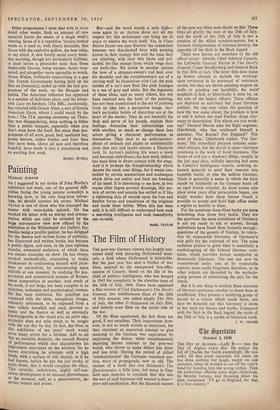Painting
MICHAEL AYRTON
As I suggested in my notice of John Bratby's exhibition last week, one of the greatest diffi- culties facing the young painter nowadays is knowing how, to his own long-term advan- tage, he should conduct his career. Michael Ayrton is one of those who has managed the matter with remarkable aplomb. He has worked his talent with an energy and concen- tration which can only be revealed by the large retrospective view now offered by the exhibition at the Whitechapel Art Gallery, for, besides being a prolific painter, he has designed for the theatre and various forms of publicity, has illustrated and written books, has become a public figure, and even, in the past eighteen months, attempted sculpture, of which there are sixteen examples on show. He has always Worked methodically, attempting to tackle Weaknesses by confronting himself with prob- lems or correctives, by concentrating upon Still-life at one moment, by studying the pro- portional and symmetrical systems of Renais- sance composition at another. And much of his work, if not large, has been complex in its structure, technique and psychological content. He has been ambitious. His paintings are crammed with the ideas, metaphors, images, scholarly references, to be expected from a man widely travelled and read, devoted to music and the theatre as well as unusually knowledgeable in the visual arts, an artist who probably does not miss much to be caught With the eye day by day. In fact, the ideas in this exhibition of ten years' work would serve many artists for a lifetime. Add to all this an enviable dexterity, the smooth fluency of performance which also characterises his impromptu utterances on the wireless; for he leaves everything he attempts with a high finish, with a surface of tidy finality, as if he had known, before he put the last stroke of Paint down, that it would complete the effect. This versatile, industrious, highly self-con- scious development is an unusual phenomenon at the moment, and, as a phenomenon, de- serves respect and praise.
But—and the word stands a mile high— once again in an Ayrton show not all my respect for this seriousness can bring me to enjoy or admire the work itself. Yes, in Vines Before Easter one may discover the connection between two thin-limbed boys with pruning knives in their stumpy fists and the trees they are climbing, with their thin limbs and pol- larded, fist-like stumps from which twigs start out knife-like. We notice in another picture the bow of a chimney-sweep's rod bent over his shoulder and the complementary arc of a curving wall: In Dominican with Cats the pink insides of a cat's ears float like pink lozenges in a sea of grey and white. But the ingenuity of these ideas, and so many others, has not been received into the body of the painting, has not been transformed in the act of painting from an idea into a persuasive image. Ayr- ton's particular habits of distortion are at the heart of the matter. They do not intensify the flesh and nerve of his people, explain their feelings, dramatise their relationships one with another, so much as change them into actors giving a character performance as themselves. They lead to an anthropomor- phism of animals and plants so sentimentally close that cats and lambs assume a Disneyite look. In Ayrton's painting life wears a mask and becomes melodrama; his best work, indeed, has been done in direct contact with the stage. And it is perhaps his draughtsmanship which throws the mask over things, for it seems con- trolled by certain mannerisms and arabesques which drive out reality and limit the freedom of his hand. It is interesting to see how, in two copies after Ingres portrait drawings, this pat- tern of curves and accents has settled as if like a tightening skin of varnish upon the free and flexible forms and transitions of the originals and made them brittle. When this has been said, it is still difficult to understand how such a searching intelligence and such insensitivity can co-exist.
BASIL TAYLOR


































 Previous page
Previous page